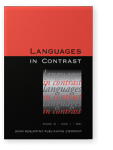Lamar A. Graham
List of John Benjamins publications for which Lamar A. Graham plays a role.
2023 Chapter 4. Derived verbs and future-conditional stem regularization in written Spanish in synchrony and diachrony Innovative Approaches to Research in Hispanic Linguistics: Regional, diachronic, and learner profile variation, Fernández Cuenca, Sara, Tiffany Judy and Lauren Miller (eds.), pp. 82–105 | Chapter
Spanish verbs derived via prefixation prescriptively retain the morphological complexity of their root verbs. However, some verbs derived from decir and hacer show allomorphic variation in the future and conditional, which is documented by the RAE for decir but not at all for hacer. The results… read more
2021 On clitic placement and gradience of strength of FP in Western Ibero-Romance Languages in Contrast 21:1, pp. 1–27 | Article
Old (Medieval and Classical) Spanish permitted finite enclisis and as such is classified as a strong-F language, as are many archaic varieties of Romance languages. Notable about Old Spanish is that, prior to the 1500s, interpolation arrangements were acceptable and rather common, as is still… read more
2021 Personal vs. personalized infinitives in Ibero-Romance: Historical origins and contact-induced change Spanish Socio-Historical Linguistics: Isolation and contact, Chappell, Whitney and Bridget Drinka (eds.), pp. 49–76 | Chapter
The infinitives of several Romance languages can appear with an overt subject. Languages such as Portuguese and Galician feature inflectional morphology on infinitives with overt subjects – the commonly named personal infinitives, such as (nós) dizermos ‘us to speak’. Other languages, such as… read more
2018 An analysis of morphosyntactic variation in the Old Spanish future and conditional Journal of Historical Linguistics 8:2, pp. 192–229 | Article
The presence of two forms of the future and conditional paradigms in Old Spanish is well-attested. The analytic form, which was marked by a mesoclitic, was more syntactically restricted, while the synthetic form, which surfaced with either a proclitic or an enclitic, was essentially free to… read more
2018 Variation in hesitation: The case of este vs. eh in Latin American Spanish Spanish in Context 15:1, pp. 1–26 | Article
This study explored the influence of social and syntactic-pragmatic factors on a speaker’s choice between hesitation markers este and eh in oral discourse. Data collected from San Juan (PR), Mexico City, Montevideo, and Medellín were analyzed as a large corpus and on an individual country basis.… read more




